The deadline for submitting 2028 Chess Olympiad bid approaching
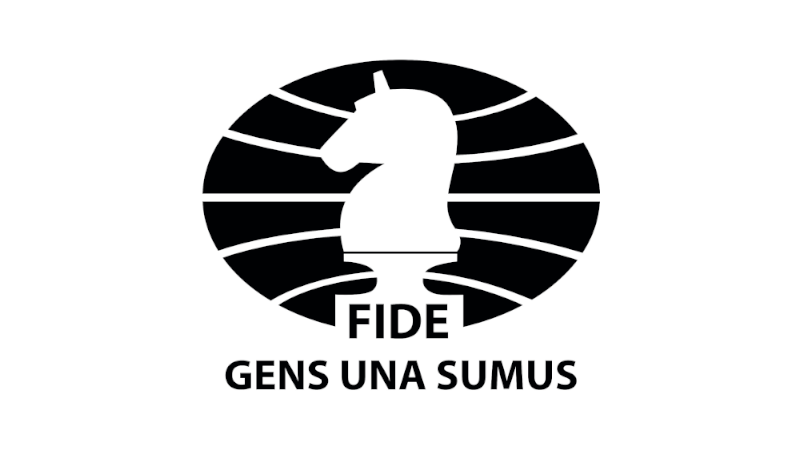
On August 15, 2023, FIDE opened a bidding procedure for the 2028 Chess Olympiad. As a part of the Olympiad bid, the bidder should also hold the Chess Olympiad for People with Disabilities and FIDE Congress. The first four weeks were allocated to the expression of interest process. Potential bidders could express their interest by 6 p.m. CET on September 12, 2023. During this period, four potential organisers have come forward. As a result, the bidding process will now last 12 weeks, as per the decision of the FIDE Council. Therefore, the deadline to submit bids to office@fide.com is now set for 6 p.m. CET on November 7, 2023, which is eight weeks from September 12. Each bidding application shall be filed per the form provided in Appendix 3 to the Regulations. The Applicant shall attach the following: Letters of support from a national federation and relevant local authorities, Supporting documents (government letters, contracts, bank guarantees, etc.) at the total amount of the bid’s budget. Irrevocable guarantee issued by: a) any of the Top 100 World Banks rated on The Bankers database or another bank which may be agreed with FIDE or b) a verified government guarantee for the amount of three hundred thousand (300,000) Euros to support the bid. Additional documents may be requested by FIDE for further evaluation. The complete requirements from the organiser, including financial obligations, are determined by section 6 of the Regulations. For any relevant clarifications regarding the regulations and application requirements, the applicants are kindly asked to send a written enquiry to office@fide.com The nearest General Assembly shall award the right to host the events to the Applicant with the highest number of votes received. Regulations: Regulations for 2028 Chess Olympiad Regulations for 2028 Chess Olympiad for People with Disabilities FIDE Congress
FIDE Executive Director visits East African counties
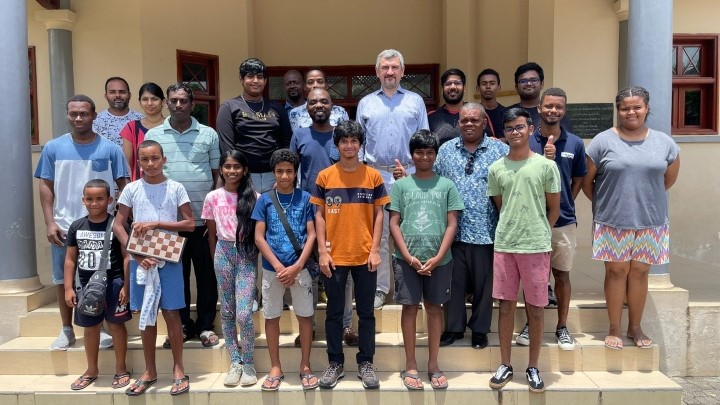
In October 2023, the Executive Director of the International Chess Federation Victor Bologan visited Madagascar, Mauritius and Seychelles, where he held several high-level meetings with local authorities and chess officials and gave simuls to enthusiasts of the game. Victor Bologan used these visits as an opportunity to discuss further chess development in the region, reiterating FIDE’s support for teaching chess in schools, social initiatives, professional chess events and increasing the level of chess among the local players. The main topics discussed during the visits also included participation in various online FIDE training programs for players, arbiters and trainers from Africa, the vital necessity of inviting at least one strong player/coach per country to help increase the overall chess level of national teams, youth, and trainers, and many others. At the meetings with local sports officials, the introduction of chess into the 2027 Indian Ocean Games and the African Games 2024 was also discussed. The first stop was Antananarivo, Madagascar, on October 18, where Bologan played a blitz tournament with local players and met the officials of the National Chess Federation. Since the country will host the Zone 4.4 championship in January 2024, the organization of this event was also discussed during the meeting. FIDE Executive Director has also visited an island Nosy Be for a chess simul and a master class for the local club players. The next stop was Mauritius Islands, where Victor Bologan met Secretary General of the Mauritius Olympic Committee Hedley Han, the Honourable Minister of Youth, Sports and Leisure of the country Stephane Toussaint, the President of the Mauritius Chess Federation Hurrynarain Bhowany, its Vice-president Patrick Li Ying and Treasurer Jay Andhin. The agenda of the visits included the discussion of various initiatives on how to promote chess on the island and in the region. Among them was an ambitious project to mix tourism and chess and to organize a circuit that includes Nosy Be (Madagascar), Mauritius and Seychelles, with an open tournament on each island, connecting it with the already existing tournament in Reunion (France). Another idea was to organize a hybrid-rated tournament for the players of the Indian Ocean countries such as Maldives, Seychelles, Comoros, Mauritius, Madagascar, Sri Lanka and Reunion (France). Following the meeting, GM Victor Bologan played simul with the 20 best players from Mauritius at the Cafe Lux, Bagatelle Mall. Gavin Anderson, the reigning Mauritian chess champion, was the only player to avoid defeat and held his game to a draw. On October 29, the FIDE Executive Director visited Seychelles, where he had a meeting with the officials of the Seychelles Olympic and Commonwealth Games Association, where they discussed the possibility of chess inclusion on the list of sports disciplines for the Indian Ocean Island Games (IOIG). After the official part of the visit, Bologan played simul with local chess enthusiasts. When asked about his impressions after the visits and the future of chess in the region, the FIDE Executive Director said: “For such small countries, the level of chess is quite decent, but of course, it can be improved. We have some examples to follow, like Iceland, where they have only 370,000 citizens but as many as seven grandmasters. I know that the federations are working hard to make progress. And the reason I am here is to see how we can help to improve the level of chess.”
A thrilling Round 3 at World Amateur Championship 2023
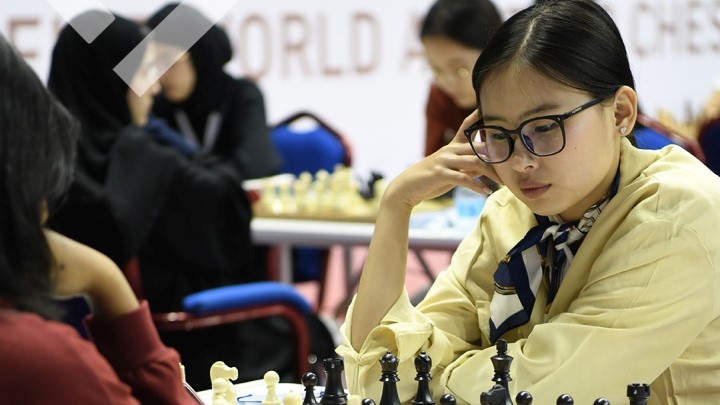
The third round of the World Amateur Chess Championship 2023 was held in Muscat, Sultan Qaboos Sport Complex, on November 4. The first traditional move was made by Eng Ismail Al Sawafi, Senior Manager of Public Relations and CSR at Oman LNG, the Gold sponsor of the event. The championship is gaining momentum after two rounds, with the top players trying to enhance their positions in all five categories. Some games stretched over five hours as contestants pressed for a win very hard. The Open U-1700 category saw a surprising turn of events when the top-ranked player, Sergei Inyushkin (FIDE), drew against Yemeni player Nawaf Saleh. There were plenty of exciting games, including Mongolian player Turbat Todmunkh’s victory over Paraguay Osmar and Omani Ahmed Al Rahbi’s loss to Shek Daniel of England. Turbat took the lead after the third round with a perfect score, followed by his teammate Munkhbat, Batnyam. In the Open U-2000 category, Finland player Esa Ahlqvist put in an impressive performance against the Indian player Ranjith, R.K., to win his third straight game. Sebastian Emil (FIDE) and Desandhi Dhihansa Gamage of Syria also scored victories to share the lead with Esa Ahlqvist. In the Open U-2300 category, Kazakhstani player Zhuban Bigabylov emerged on top after three rounds, scoring 3/3 alongside his compatriot Abilmansur, Mongolian players Aldar, Burentegsh and Sodbilegt, Naranbold with 3 points each. A highlight in the category was a fascinating duel between Syrian FM Malek Koniahli and Mahindrakar Indrajeet of India. This exciting game saw several nail-biting moments and ended with a draw. In the women’s category under 1700, there were several unexpected outcomes. Baldanjantsan Khuslenzaya, from Mongolia, notched up an impressive win against Arun Aditi of India and is now tied for the lead with her compatriots Bat-Amgalan Anujin and Naranbold Sodgerelt. The Chess Trainers Workshop organized by the Omani Chess Committee organized alongside the championship concluded today after three days of intensive training. Conducted by the International Arbiter / FIDE Trainer Ali Abbas of Syria and Bashir al Qadimi, the coach of the Omani national chess team, the workshop attracted 20 male and female trainers, all eager to enhance their knowledge in chess training. Round 4 of the World Amateur Chess Championship 2023 will start on November 5 at 1:00 p.m. CET. You can watch games live with expert commentaries on the Oman Chess Union YouTube channel. Text: WACC 2023 media team Photos: Entisar Nasser Al-omiiri, Hamed Al-Mabsali, Abduallah Al-Rashdi, Salma Hamood, Salem Al-Salhi FIDE World Amateur Chess Championship 2023 is organized by the Omani Chess Committee together with the International Chess Federation, with the financial support of Gold sponsors: Syool, Apollo Hospitals, Oman LNG. Bank Muscat, Otaxi, Oronamin C Drink as well as Diamond sponsors: Asyad, OMIFCO, and Oman Airport. Official website: https://worldamateur2023.fide.com/ Results and standings: https://worldamateur2023.fide.com/result/ Live games: Open U-2300chess24.com/en/watch/live-tournaments/fide-world-amateur-championship-2023-u2300#live Open U-2000: chess24.com/en/watch/live-tournaments/fide-world-amateur-championship-2023-u2000#live Open U-1700: chess24.com/en/watch/live-tournaments/fide-world-amateur-championship-2023-u1700#live Women U-1700 https://chess24.com/en/watch/live-tournaments/fide-world-amateur-championship-2023-w1700#live Live broadcast (English/Arabic): youtube.com/@Omanchesscommitteeoman
Grand Swiss: A trio of leaders after Round 10; Vaishali qualifies for Candidates
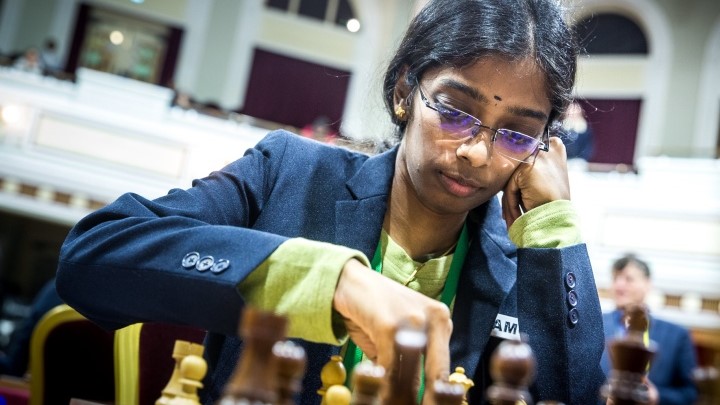
As the fight for the Candidate spots intensified, the players stepped up their efforts. A lot of decisive outcomes on the top boards mean that before the final round, the joint leaders Hikaru Nakamura, Santosh Gujrathi Vidit and Andrey Esipenko have the highest chances of both winning the tournament and securing a ticket to Toronto. In the women’s section, Vaishali R and Anna Muzychuk both won and continue to lead the tournament. The draws by the other players worked ideally for Vaishali, who punched her ticket to the Women’s Candidates with a round to spare. On board one, the all-American derby quickly went into a position with opposite-coloured bishops. They are generally an early sign of a draw, especially if they come out from a forcing line in the opening. In fact, there was a lot under the surface, and the appearances were deceiving. Hikaru Nakamura chose to transpose to the Four Knights Scotch facing Fabiano Caruana’s Petroff Defence. The Petroff was Caruana’s fireproof defence in 2018 when he used it to great effect to win the Candidates tournament and later easily hold against 1.e4 in the World Championship match against Magnus Carlsen. Nakamura’s choice, the Four Knights Scotch, is an often-used drawing line for two reasons: it leads to relatively simple positions that are easy to play; it is incredibly deeply explored, some lines leading to forced draws. However, Nakamura’s strategy in the opening was cunning. It had two layers: if his opponent remembered the most precise way to deal with the opening surprise, then a quick and energy-saving draw would be made. But if his opponent failed to do so, then he would obtain a risk-free pressure with a very likely time advantage to boot. As the game showed, it was the second possibility that happened. The moment that decided the course of the game was after White’s 12.Rd1 Caruana spent some time recalling his lines and went for the simplifying 12…Bxc3 13.bxc3 Qa5. He could have kept the position more complex with 12…Qe7, but perhaps he thought Nakamura didn’t mind a quick draw (see the first possibility explained above)? He may have been right in his assumption, but that required precision later on. As they followed an obscure game played between engines, Caruana committed a mistake that sent the game from a likely possibility number one to a definite possibility number two. The engine playing with the black pieces chose 18…Rab8, while 18…Rac8 and 18…f6 were also good moves. Caruana played 18…h6? and after 19.Bf4, he was already under severe pressure. His appearance at the board showed great concern about the position. After a further mistake with 19…Re7? (19…Rad8 was best, but even that is hanging by a thread after 20.Be5) White was on the verge of winning after 20.Re1, as Black cannot really defend the pawn on e4. Add to this that Hikaru had more than half an hour advantage on the clock, and you see the triumph of Nakamura’s opening preparation. Nakamura started to think at this point, and while he didn’t play the absolutely best move 20.Re1, he did make the second-best move in the position 20.Qe3, a tempting option that introduces ideas like Bxh6. That sacrifice happened later in the game, and coupled with the doubling on the d-file it also gave White a decisive advantage. With only eight minutes for 16 moves and his position on the edge of collapse, Black’s situation was not enviable. White continued with 28.Qh4, and soon enough, the attack on Black’s king forced Black to enter a lost endgame. Black’s rook is hanging, but there is also the threat of Re8 followed by Qg7 mate, so Black was forced to play 31…Qf4, and after the exchange of queens followed by Bg7xf6, White entered a technically winning endgame. Unlike yesterday, Nakamura didn’t allow any chances and won in 40 moves. It was an unusual game between elite players when one of them suffered an opening catastrophe. On the other hand, Nakamura won in an identical fashion against the same opponent in the last round of the Norway Chess last June. On board two Bogdan-Daniel Deac might have been surprised by Vidit Santosh Gujrathi’s choice of the Sicilian after 1.e4. The reasoning is that both players have had an excellent tournament, so as the end draws closer (no pun intended), it makes sense to play more solidly and preserve what has been achieved. White didn’t go for the open Sicilian and chose the Moscow Variation with 3.Bb5, which was met by the most complex reply 3…Nd7, keeping all pieces on the board. Both the Sicilian and the choice of 3…Nd7 indicated Vidit’s aggressive intentions for this game. Curiously enough, the position eventually took the shape of Najdorf. In line with his aggressive mood, Black transferred the knight from c5 via e6 to f4 and then launched a kingside expansion with …g5. This put White under pressure. White could have played the calm 17.Be2, avoiding the attack with …g4, though Black remains the active side. His 17.Bd2?! lost a pawn to the pretty tactic 17…g4! 18.Be2 Bxe4! With the point that 18.Nxe4 N6d5 pesters the white queen as she can no longer protect the bishop on e2. White continued with 19.Nf6, but after 19…Bxf6 Black was a sound pawn up. Vidit gradually improved his position while White dug deeply to resist on the kingside. Time trouble also became a factor. Playing on his last seconds, Deac stirred up trouble on the kingside with 34.h3. Objectively, this isn’t very good, but White didn’t want to just sit and wait while Black was making further progress. After 34…gxh3 35.Qxh5 Nf6 36.Qe2 Rd4 Black was still in control and remained so when they reached the time control. White’s last hope was that perhaps he could round up the pawn on h3 but it was dashed by Vidit’s energetic play. On board three Andrey Esipenko chose his favourite Catalan against Parham Maghsoodloo. Still, it was Black who chose a rare early on with 7…h6. Moving the h-pawn is generally useful for Black, controlling the g5-square and waiting to see how White continues with development. White chose the standard development with 8.Qc2 and 10.Bf4 and Black went down a line
Gunpowder fireworks in Round 9 of FIDE Grand Swiss
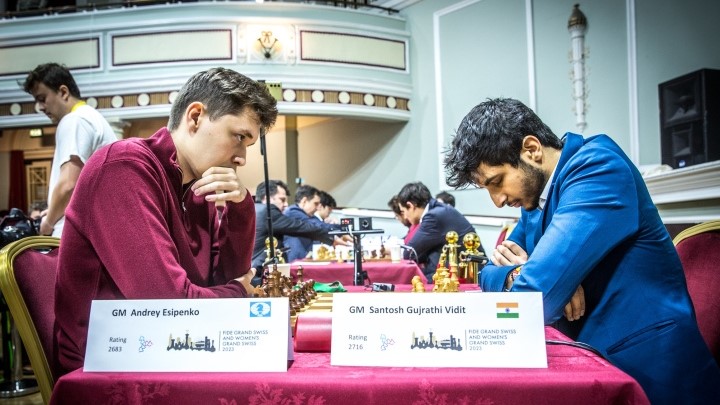
The ninth round of the FIDE Grand Swiss started earlier than usual because of the planned celebration with loud music and fireworks of the Gunpowder Plot. Most of the players were in a fighting mood, but chances were missed left and right. Fabiano Caruana messed up the opening and risked losing against Bogdan-Daniel Deac. Hikaru Nakamura needed two mistakes by Ivan Cheparinov to win a technically winning position. Parham Maghsoodloo beat Alexey Sarana to join the five other players in the lead with 6.5 points. In the women’s section, Rameshbabu Vaishali topped Antoaneta Stefanova with the black pieces to emerge as the sole leader with 7 points, ahead of Anna Muzychuk and Tan Zhongyi with 6.5 points. Round nine started three hours earlier than usual for the open section and an hour and a half earlier for the women’s section. The reason for this was the planned firework celebrations for the commemoration of the Gunpowder Plot – an attempt by Guy Fawkes to blow up the Parliament and kill King James I on 5 November 1605. Fortunately, this plot failed, so in Britain, its failure is celebrated by big fireworks. At 6:30 pm, fireworks and loud music were planned to take place some 150 meters from the Villa Marina, so in order not to affect the players, the organisation decided to move the round earlier. It is not easy to adapt to changes in the usual routine, and this particularly applies to chess players, who like to have their days as predictable as possible. The brain gets used to hard work at certain hours, and then suddenly shifting this time to an earlier hour may result in the brain protesting and not functioning at optimal capacity. Be that as it may, the players were at their boards at 11:30 am, and the round started without anybody being late. A crow that somehow found its way inside the venue celebrated this punctuality with loud caws for several minutes before seeing itself outside in the sunny weather. On board one, Fabiano Caruana used a rare idea in the Giuoco Piano against Bogdan-Daniel Deac. It has been employed only once before, in a correspondence game played in 2020. White usually plays 12.a4 in this position, but Caruana went for 12.Bd5!? instead, immediately using the fact that Black’s knight is no longer on f6 controlling the d5-square. The idea of the bishop move is to allow for the Nc4-e3 maneuver to target the weakened f5-square. This move set Deac thinking, but despite that, the opponents followed the correspondence game Muljadi – Burgarth until move 16, when Deac deviated by castling short. Whether it was because of the early starting hour or not, Caruana forgot his preparation and immediately ended up in a dangerous position. The position required concrete actions – 17.Nf5 Qf6 18.d4 with an unclear position. Caruana played the slow 17.a4? and after 17…g4! 18.hxg4 hxg4 19.Nh2 Qg5 was in real trouble. He pursued his queenside activity with 20.b5, and here, Black missed a golden opportunity. Bogdan-Daniel played the natural 20…Na5, and after the queen retreated to c2 he won a pawn by taking on e3 twice. However, Black could have played the very strong 20…Nf4! which would have given him a big advantage. The point of the move is that it doesn’t really sacrifice a piece because Black has …Ne2xg3 with checks when the knight on e3 is lost. After Black won a pawn, White exchanged queens and obtained sufficient compensation for the pawn in the form of his better pieces and control over the f-file. White threatens with Ne3, transferring the knight to an excellent square, where it targets the pawn on g4 and controls the f5-square. Caruana used his activity to regain the pawn and a draw was reached after 43 moves. On board two, Vidit Santosh Gujrathi chose a popular line against Andrey Esipenko’s Ruy Lopez. In this line, White defends the e4-pawn with d3, saves his bishop from an exchange by playing a3 and develops the queen’s knight on c3. Esipenko chose a variation where he exchanged the light-squared bishops, and soon enough, the players could have repeated moves. Many games were here with the repetition 15.Bg5 Ng4 (or 15…Nd7) 16.Bd2 Nf6, but Vidit decided to continue the game with 15.Re1. The ensuing play unfolded on the queenside, where the a and b pawns were exchanged. The open files gave White some initiative, but Black remained solid. Without weaknesses on either side White’s control over the open files on the queenside can bring little. After the queens, one pair of rooks and the bishops were traded, a draw was agreed on move 37. On board three, Hikaru Nakamura confidently played 1.e4 against Ivan Cheparinov, which was met by the Petroff Defence, a recent addition to Ivan’s repertoire. After the standard moves, Nakamura opted for the sideline 5.c4, aimed at reaching the usual Petroff positions by avoiding the main theoretical lines after the more usual 5.d4 d5 6.Bd3. Even in a sideline, Cheparinov was well prepared and obtained a good middlegame position as both players finished development. White’s IQP gave him a space advantage and free-piece play, while Black achieved smooth development, leading to a dynamically balanced middlegame. The decisive moment in the game came relatively early. After 10 minutes of thinking, Cheparinov went for the pawn sacrifice 17…Nf5? instead of the composed 17…Rb8 or 17…Qd6 (intending to meet 18.Bxd6 with 18…cxd6) defending the attacked pawn on b7. As it turned out, the sacrifice was not sound. After only three minutes, Nakamura picked up the pawn for nothing with 18.Nxb7 Qd5 19.Nc5. Perhaps what Cheparinov missed was that here 19…Bxc5 fails to 20.Re5! and White retains his extra pawn. Further exchanges followed, and by move 30, White had a technically winning position. Nakamura is usually flawless when converting material advantage, and up to a certain point, that was the case in this game, too. However, on move 36 an interesting moment arose. You wouldn’t expect it in this situation that White has only one (!) move to keep the winning advantage, but that was the case here. The move in case
Caruana misses a Tal-like combination, but still wins in Round 8 of FIDE Grand Swiss
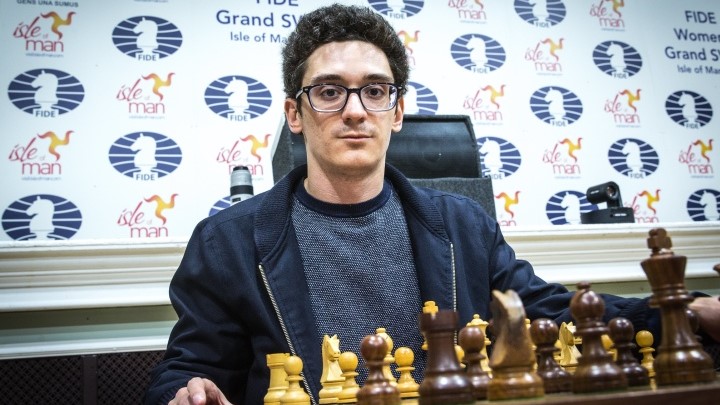
The leader Vidit Gujrathi drew his game against HikaruNakamura and allowed Bogdan-Daniel Deac, Fabiano Caruana and Andrey Esipenko to join him in the lead. The chasing pack consists of 11 players sitting half a point behind the leaders. In the women’s section, all three leaders, Antoaneta Stefanova, Anna Muzychuk and Rameshbabu Vaishali, drew, maintaining the lead ahead of Sophie Milliet, Leya Garifullina, Tan Zhongyi and Batkhuyag Munguntuul. On board one, the leader Vidit Santosh Gujrathi met Hikaru Nakamura’s Sicilian with the latter’s preference – the Alapin Variation. The Alapin is considered a very safe choice for White, especially in the lines where White doesn’t allow the creation of an isolated queen’s pawn (IQP) on d4. Usually, a typical situation arises where White has three pawns versus two on the queenside while Black has four pawns versus three on the kingside. These positions are slightly easier to play for White because his queenside majority is easier to move forward. Nakamura deviated from his choice against Raunak Sadhwani from the second round, where he went for the more fighting option of the fianchetto of the dark-squared bishop. Today, he went for the more conservative development with …e6 and slightly deviated from a previous game of his (where he took 6…cxd4) in favour of the move 6…Qd8, recently also played by Magnus Carlsen. This deviation set Vidit thinking for 35 minutes (!). As he said after the game, this was an attempt to figure out the possible move-order transpositions and the best way to continue. Eventually, he went for 7.Nc4, the most commonly played move in the position. The critical position arose on move 10. Here, White had a promising plan of 10.Qe2 followed by Nce5, h4, Ng5, possibly 0-0-0, Rh3-g3, etc., with a dangerous initiative. In the post-mortem, the players couldn’t find a satisfactory set-up for Black. When asked, Vidit said he was sorry he didn’t go for this, and the reason was that he “misevaluated the position.” He went for 10.a4, and then a short castle, but a move repetition after …Nh5, Be3 Nhf6, Bf4 Nh5 ended the game in a draw. On board two Fabiano Caruana used a relatively forgotten line against Etienne Bacrot’s Taimanov Sicilian. After choosing the line with 6.Be3 a6 Caruana played the move 7.a3, which for some time in the 1960s was a favourite of Mikhail Tal. The idea of the move is to prevent the typical Taimanov pin with …Bb4, thus allowing for a more aggressive set-up with f4, Qf3, etc. This is how Tal used to play when Black replied with 7…Nf6. Bacrot chose the more direct 7…b5, intending …Bb7 with quick queenside development while at the same time having in reserve the …b4 push. White exchanged on c6 and continued with the development of the kingside with Be2 and 0-0. As is his habit, Bacrot started spending a lot of time, and by move 13, he had 35 minutes less than his opponent while the engine wasn’t thrilled with his position. White continued forcefully, and after exchanging, the dark-squared bishops started to pile up pressure on the backward d7-pawn. In order to get rid of this pressure, Black pushed …d5, but this led to the creation of an IQP on d5. In addition to another isolated pawn on a6, White had a solid advantage. What made things worse for Black was that the position was very one-sided, and he had no counterplay. Caruana increased his advantage, but in spite of the position being safely in his favour, it wasn’t easy to find a breakthrough. He missed a deeply concealed one on move 31. Caruana played 32.Qb2 and after 32…Rc8, the worst was behind Black. The winning move was 32.Qa1!! with the deep idea of c4 and Nh5. It is very difficult to see an attack both on the queenside (the bishop on b5) and the kingside (the mating threat on g7 after the rook leaves the d4-square). It takes a lot of imagination to discover a move like Qa1, something the Great Wizard of Riga had in abundance. Unfortunately, playing Tal’s variation in the opening wasn’t enough for Caruana to complete the full circle and play like Tal the whole game. The lines are not easy to calculate but had Caruana spotted the idea, he would undoubtedly have seen the lines, too. After missing this chance, Caruana couldn’t do much against Bacrot’s precise defence, and the game was heading to a draw. However, Bacrot’s time trouble cost him the most important half a point. Black’s position is exposed, but he can still draw after 55…Rb3. In the game he played 55…Nc6? which after 56.Nxc6 Rxc6 57.Ra5! forced a winning rook endgame for White. After the exchange on a5, White placed a rook behind the passed a-pawn, and Bacrot resigned. On board three Andrey Esipenko had some “compensation” for being caught in the opening yesterday, as today he did the same with Vincent Keymer in some sharp preparation in the Reti Opening, at least judging by the time both players spent on their first 19 moves. Keymer opted for the early advance of the d-pawn, a line that became popular after Magnus Carlsen used this type of development in his match against Ian Nepomniachtchi in game nine of their match in Dubai in 2021, a game that Carlsen won. In this position, the automatic recapture on d4 with the pawn would lead to calmer play, but Keymer went for the engine’s preferred line of 7…e4, which was met by the engine’s second choice of 8.d5. White sacrificed material to obtain strong central pawns on d5 and e5. Keymer started spending a lot of time on his moves (for example, his 11th move took him almost 20 minutes) while Esipenko continued to play a-tempo. The curious thing was that both players followed the engine’s best line, a clear indication that they had analysed this before, with the difference that Esipenko had revised his notes before the game while Keymer was trying to remember his. Here the engine suggests chipping away at White’s centre by 18…c6 (or 18…Kd7 and then …c6), but after 13 minutes of
FIDE World Amateur Championship 2023 kicks off in Muscat, Oman
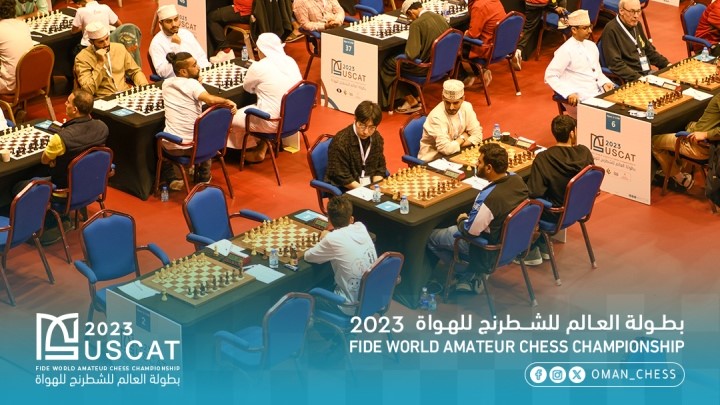
The World Amateur Chess Championship 2023 officially commenced on Thursday evening in Muscat, marking the beginning of an exciting competition that brought together amateur chess players from around the globe. Organized by the Omani Chess Committee, in partnership with the International Chess Federation, the championship runs from November 2 to November 11 in the main sports hall at the Sultan Qaboos Sports Complex in Bawshar. During a technical meeting on Thursday morning, the essential modifications to the rules and the playing system were discussed and clarified. These changes aim to enhance the competitiveness and fairness of the championship. Mahdi Abdulrahim, a distinguished member of the International Chess Federation, offered valuable insights into the rules and regulations that players must adhere to while inside the playing hall. The championship will also rigorously enforce fair play and time control measures in accordance with the FIDE rules and regulations. The championship is held in five categories: U2300 Open, U2000 Open and U1700 Open, U2000 Women and U1700 Women. All five competitions are 9-round Swiss tournaments with classical time control. Each championship day starts opening move at 4 PM. Ozgur Solakoglu, FIDE Technical Delegate and Honorary Chair of the FIDE Events Commission expressed his pleasure of being a part of the World Amateur Chess Championship, with over 400 players hailing from as many as 64 different countries. He emphasized that this remarkable turnout might be a historic record for the World Championship, giving the event status of a truly global competition. Mr Solakoglu also praised the favourable conditions and the absence of any complaints from the players. He expressed hope for a successful and competitive tournament and commended special trips for the players to explore the unique attractions of Muscat, enhancing their tournament experience. He concluded by stressing the vital role of amateur tournaments in the world of chess, as they form the foundation of the sport and provide a platform for the countless amateur players worldwide to engage with chess and foster the game’s growth and visibility. The first round of the championship was honoured by the presence of His Excellency Mr Said bin Sultan al Busaidi, the Undersecretary of the Ministry of Culture, Sports, and Youth for Culture, who made the first ceremonial move together with the President of the Oman Chess Committee Mr Ahmed Al Bulushi. Official website: worldamateur2023.fide.com/ Pairing and results: worldamateur2023.fide.com/result/ Live games: Open U-2300chess24.com/en/watch/live-tournaments/fide-world-amateur-championship-2023-u2300#live Open U-2000: chess24.com/en/watch/live-tournaments/fide-world-amateur-championship-2023-u2000#live Open U-1700: chess24.com/en/watch/live-tournaments/fide-world-amateur-championship-2023-u1700#live Women U-1700 https://chess24.com/en/watch/live-tournaments/fide-world-amateur-championship-2023-w1700#live Live broadcast (English/Arabic): youtube.com/@Omanchesscommitteeoman Text and photo: WACC 2023 media team
FIDE November 2023 rating list published
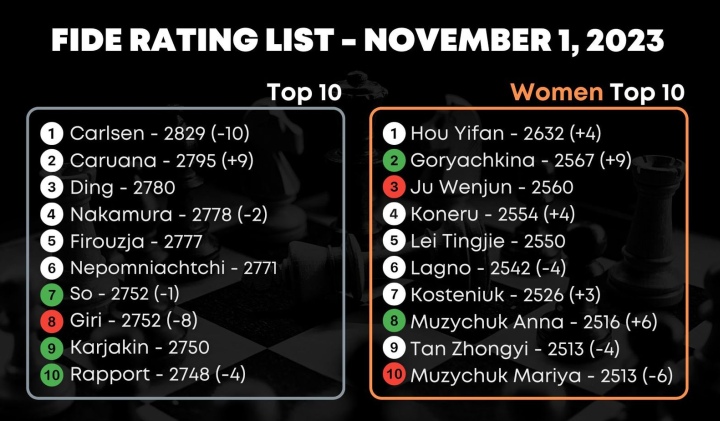
The November 2023 FIDE rating list was primarily impacted by the U.S. Championships, the European Club Cup, the 19th Asian Games Chess Team Competitions and the Qatar Masters. Fabiano Caruana consolidated his second position in the top 10 open after winning his second straight U.S. Championship title and picking 9 rating points, while Wesley So dropped one point despite finishing second but still moved three positions up in the top 10. Photo: Crystal Fuller | Saint Louis Chess Club After a long pause, women’s #1 Hou Yifan played nine classical games in the 19th Asian Games and earned four points – her first standard rating increase since December 2019. Biggest gains in top 100 Open and Women Yakubboev, Nodirbek GM 2643 (+28) Yip, Carissa IM 2399 (+27) Maghsoodloo, Parham GM 2732 (+25) Sindarov, Javokhir GM 2681 (+23) Tokhirjonova, Gulrukhbegim WGM 2370 (+20) Nurmanova, Alua WIM 2367 (+20) Vaishali, Rameshbabu IM 2467 (+19) Lee, Alice FM 2406 (+18) Artemiev, Vladislav GM 2714 (+17) Narayanan S L GM 2668 (+17) Nodirbek Yakubboev (pictured below) triumphantly returned to the top 100 Open after a 10-month absence following his solid performance at the 19th Asian Games (+9) surprising victory in Qatar Masters (+18) and won this nomination. Photo: Qatar Masters His teammate Javokhir Sindarov also did a great job in these two competitions (tying for third in Qatar), translating into 23 rating points. India’s Narayan also became one of the rating beneficiaries in Qatar. Three young players who made it to the podium of the U.S. Women’s Championship – the champion Carissa Yip (+27), the runner-up Gulrukhbegim Tokhirjonova (+20) and the bronze winner Alice Lee (+20) – substantially increased their rating with Alice reaching her career-high. Photo: Lennart Ootes | Saint Louis Chess Club Parham Maghsoodloo (pictured below) led team Iran to the gold medals at the 19th Asian Games, scoring a spectacular 7.5/9 on the first board. Coupled with a solid showing in the Qatar Open and Bundesliga, these results brought him 25 rating points, signifying his return to the 2700+ elite group. Photo: Niki Riga Alua Nurmanova underperformed in the 19th Asian Games (-11) but made up for this rating loss in the Qatar Open, where she gained an impressive 31 points. The same applies to Rameshbabu Vaishali, who netted a mere 0.1 points in the team competition but added 18.8 points to her tally in Qatar and completed her final GM norm along the way.
Nakamura invokes Fischer’s spirit in Round 7 of FIDE Grand Swiss
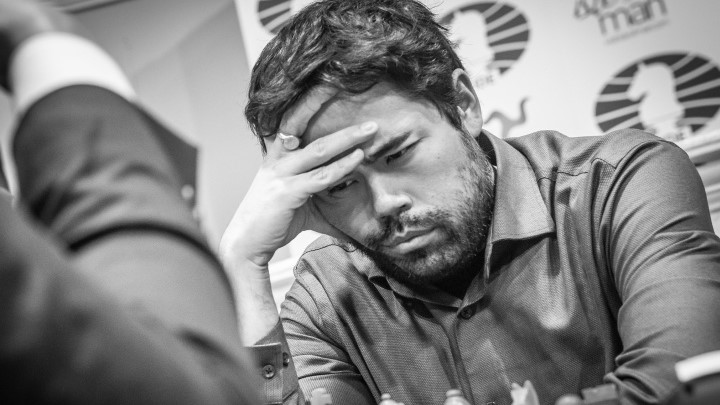
The number of draws on the top boards doesn’t tell the whole story of hard-fought games, with plenty of interesting opening ideas and spectacular sacrifices. Fabiano Caruana essayed a rare move in the Semi-Slav tabiya, while Hikaru Nakamura hoped for inspiration by employing Bobby Fischer’s favourite variation against the Sicilian Defence. Santosh Gujrathi Vidit spotted an incredible tactical shot to beat Javokhir Sindarov and emerge as the sole leader as his friend Arjun Erigaisi couldn’t break Andrey Esipenko’s defence in an epic battle that lasted for 90 moves. In the women’s section, the draw on board one between Aleksandra Goryachkina and Anna Muzychuk meant that victories by Rameshbabu Vaishali and Antoaneta Stefanova (against Bibisara Assaubayeva and Mariya Muzychuk, respectively) allowed them to join the lead to form a trio at the top. The opening surprises were in no short supply on the top boards in Round 7 of the FIDE Grand Swiss. On board one, Radoslaw Wojtaszek played Fabiano Caruana and, just like in his round four game against Anish Giri, faced an opening he prepared together with Anand’s team in 2008 for the match against Vladimir Kramnik. In that match, the Semi-Slav (and the subsequent Meran) was Anand’s main defence against 1.d4, bringing two invaluable victories on the way to winning the title. Caruana doesn’t play the Semi-Slav often, so his choice was aimed at forcing his opponent to recall lines he hadn’t looked at in his pre-game preparation. The Semi-Slav is a fighting choice, so Caruana showed his aggressive intentions early on. He also introduced an early twist. In the tabiya of the Semi-Slav, Caruana went for a less common move. In this position, the most common move for Black is 8…dxc4 (played by Anand many times, where he demonstrated several ideas from their preparation), but there are also moves like 8…e5, 8…h6 or 8…Qe7. Caruana played 8…Re8, the move recently employed by the young talents Samuel Sevian and Mittal Aditya. Wojtaszek likes to think, and this move gave him something to mull over. He followed the theoretical path, but by move 14, Caruana had a 40-minute advantage on the clock. In addition to that, he also introduced a novelty on that very move. There are several computer games from this position, and in all of them, Black played 14…Bc7, but Caruana preferred 14…Nge5. After the exchange of knights, Wojtaszek retreated the bishop to e2. Needless to say, Caruana was still well into his preparation as Wojtaszek had less than an hour to reach move 40. The ensuing middlegame was balanced. White advanced his central majority with f4 and e5, to which Black replied with …f6-f5, establishing a blockade on the e6-square. At first sight, it may appear that the protected passed pawn gives White a solid advantage, but in fact, this blockade, which can also happen from some lines of the Berlin, is known to effectively neutralize White’s extra pawn on that side of the board. Here’s an illustration of Black’s blockade. White cannot make any progress. The queens were exchanged, and then Black advanced with his own pawn majority. Fabiano made certain progress and even managed to exchange his a-pawn for White’s b-pawn, thus creating a passed pawn on the c-file. He advanced this pawn as far as c3, but this still wasn’t enough to tip the balance. The following position was reached after Black’s 60th move. Draw was agreed one move later. On board two, Hikaru Nakamura faced the Four Knights Sicilian against Alexandr Predke. This variation, which arises after 1.e4 c5 2.Nf3 e6 3.d4 cxd4 4.Nxd4 Nf6 5.Nc3 Nc6 has become very popular for several reasons: one is that it allows Black to avoid the Rossolimo by playing 2…e6, and the second is that after 6.Ndb5 Black can choose between the Sveshnikov Sicilian with 6…d6 7.Bf4 e5 8.Bg5 a6 or the very safe line 6…Bb4, third is that the complications after 6.Nxc6 bxc6 7.e5 Nd5 works nicely for Black. Therefore, it’s not a surprise that many players have chosen to avoid all of the above with moves like 6.Be2 or 6.a3, the latter one chosen by Nakamura. The little pawn move stops the pin with …Bb4, but this tempo allows Black to transpose to the Scheveningen setup where the move a3 isn’t strictly necessary. Nakamura’s twist came two moves later. Instead of the usual Scheveningen setup with 8.Be2 Hikaru chose the Sozin Attack with 8.Bc4. The Sozin was a fearsome weapon of the great Bobby Fischer. He was attracted to it because of the simple and straight-forward positional idea – White’s bishop on the a2-g8 diagonal is blunted by the pawn on e6, so White simply plays f4-f5 to attack that pawn, and in case of …e5, the diagonal for the bishop is opened and the bishop becomes a very strong piece. Modern theory hasn’t been kind to the Sozin Attack, as reliable defensive methods for Black have been found. Even Fischer gave up on it after the fourth game in his match with Spassky in Reykjavik in 1972 when Spassky countered it in a very effective fashion. And yet, here we are in 2023, and we see another American resurrect the fearsome weapon of his predecessor. Fischer had a lot of quick wins in his pet line by employing the f4-f5 advance and then using the weakened d5-square for his pieces. This was mostly because his opponents didn’t know how to react to this plan. Nowadays, Black players know what to do, and Predke wasn’t an exception. While White did take control over the d5-square, he had to give up something in return – in this case, the dark-squared bishop. Black obtained an excellent position thanks to his control of the dark squares, with the dominant bishop on e5 being the key piece. After White took the pawn on b7, Black responded with …Rb8 and took on b2. The position was heading to mass simplifications and a draw, but inaccuracies crept into Predke’s moves, and somewhat unexpectedly, White won a pawn. White didn’t really have realistic winning chances, but a pawn is a
FIDE Infinite Chess project for children with ASD keeps growing
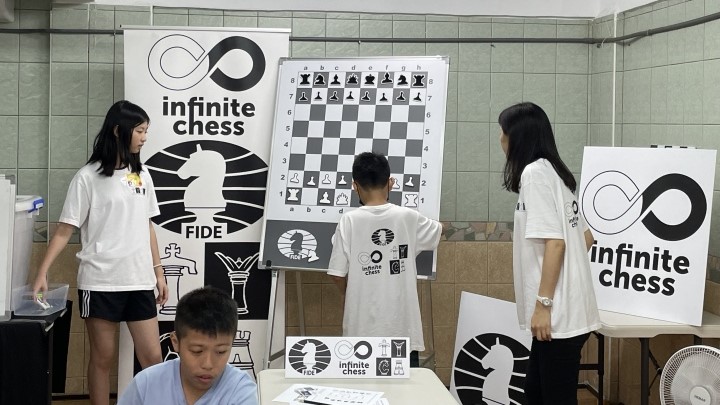
The FIDE Infinite Chess project, aimed to teach chess to children with autism spectrum disorder (ASD), continues to expand throughout the world. Spearheaded by Anastasia Sorokina, Chair of the FIDE Commission for Women’s Chess, a pilot project was launched in January 2021 in six countries: Spain, Turkey, France, Gibraltar, South Africa and Norway. Currently, it is already running in 12 countries – Albania, Cyprus, France, Gibraltar, Latvia, Malaysia, Mongolia, Morocco, South Africa, Spain, Taiwan, and Turkey – and involves 130 children with ASD. Three new partners – New Zealand, Maldives and India – have joined the project in October 2023. From September to December 2023, “Infinite Chess“ students will attend 17 lessons in groups with ASD children only or in inclusive mixed groups. The classrooms are equipped according to FIDE Infinite Chess guidelines. With the support of the International Olympic Committee, the program is planned to be launched in African and American regions. Pre-launch activities are now underway in Brazil, Puerto Rico, Nigeria and Botswana, where the first chess classes will be held there this winter. In November 2023, the 4th FIDE Educational Seminar of Infinite Chess Project, “Chess for children with an autism spectrum disorder. Learn and teach”, will be held. It aims to provide core knowledge and practical advice to teachers, trainers, and parents who wish to teach chess to kids with Autistic Spectrum Disorder. The “Infinite Chess” training program for teaching chess to children with autistic spectrum disorder (ASD) is available in several languages — English, French, Spanish, and Russian. Recently, it has been translated into Arabic language and published on the project’s website. The list of activities planned for this year also includes the Social Project Conference in Paris, France (December 06-09, 2023) and the educational seminar for teachers in Dubai, UAE, in cooperation with the FIDE Trainers’ Commission and the Asian Chess Federation (December 18). To learn more about the initiative, visit its official webpage: infinitechess.fide.com

